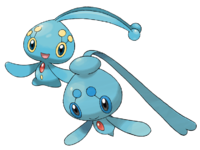On the Origin of Species: Manaphy and Phione
|
|
As we've discovered so far, there are many Pokémon based on concepts peculiar to Japan; Pokémon whose origins would be obvious to any Japanese player, but would be likely to elude the average Western fan. Generally, these are Pokémon based on folklore and traditions, like Castform and Mawile. But occasionally, the same thing will happen with Pokémon based off real creatures. There are many animals that are hugely popular in Japan while remaining obscure elsewhere. Today's Pokémon might just be the most high-profile examples of this phenomenon in the whole series.
Manaphy is a Legendary Pokémon, generally obtainable only from the Pokémon Ranger games, or from events. Breeding Manaphy will result in Phione, which has a similar appearance. Both of these Pokémon are based upon a certain tiny creature much loved by the Japanese: an eerily beautiful sea slug called a clione.
That's right; Manaphy and Phione are slugs. It may seem surprising given their appearance, and also given the fact that Shellos and Gastrodon, also based on sea slugs, were introduced in the same generation. The truth is that marine gastropods can vary enormously in appearance, and represent a huge number of species, with more being discovered all of the time.
Clione are often referred to as sea angels, and it isn't difficult to see why. These small, semi-transparent creatures move around with the help of wing-like extensions to the body, making them look like a silhouetted angel. In addition, the internal organs, colored a pinkish-orange, are visible through the skin. Strangely, this has the effect of making the clione seem even more angel-like, contrasting as it does against the bluish-white of the wings.
Beauty doesn't always imply serenity, though, and it might be surprising to learn that the clione is a fearsome predator. They're fast and extremely agile, and prey on smaller creatures. When feeding, they make a quick transition from a cute, anthropomorphized angel to a weird, alienesque creature. A clione's mouth is located in what seems to us to be the top of its head. Cone-like extensions around the mouth reach out and pull prey in, which is then latched onto by hooks around the throat, ensuring it can't escape.
They can be found in oceans around the world, though Japan is mostly familiar with Clione limacina, which favors the cold water around Hokkaido (upon which the Sinnoh region of Diamond, Pearl and Platinum was based). A closely related species populates the waters around the Antarctic, while clione of various kinds can be found in many places, including the Pacific coast.
It's difficult to describe just how obsessed Japan is with the clione. Not only are they mainstays of Japanese nature documentaries, there are also clione toys, clione jewelry and... well, just about anything you can imagine. Sanrio have even produced a clione Hello Kitty, in both key ring and plush form. If you're an Animal Crossing player, you might well be familiar with the clione, albeit under a different name: the games call them sea butterflies. Strictly speaking, 'sea butterfly' is used to refer to a different (though related) group of marine gastropods, but some scientists still use the terms interchangeably.
Both Manaphy and Phione incorporate many elements of the clione into their designs. The glowing red 'jewels' on their bodies are inspired by the creatures' red internal organs, and both also possess the distinctive wings and antennae. Personally, Phione is my favorite design of the two, just because it appears a little more clione-like, but both of them can be said to capture the creature's quirky charm.
Manaphy and Phione's names, which are the same in Japanese, have always been a bit of a mystery to me. While Phione obviously comes from clione, the other elements have no clear origin. One Japanese site speculates that the "phi" common to both names might come from Captain Constantine Phipps, an English explorer who undertook a famous voyage to the Arctic. During his voyage, he became the first European to describe the polar bear, the ivory gull and, yes, the clione. It's a long shot, perhaps, but I find this to be as good an explanation as any.
Manaphy and Phione show us once again that the Pokémon franchise can teach us a lot, not just about Japanese culture, but about the wonderful and often ignored creatures that are all around us.

